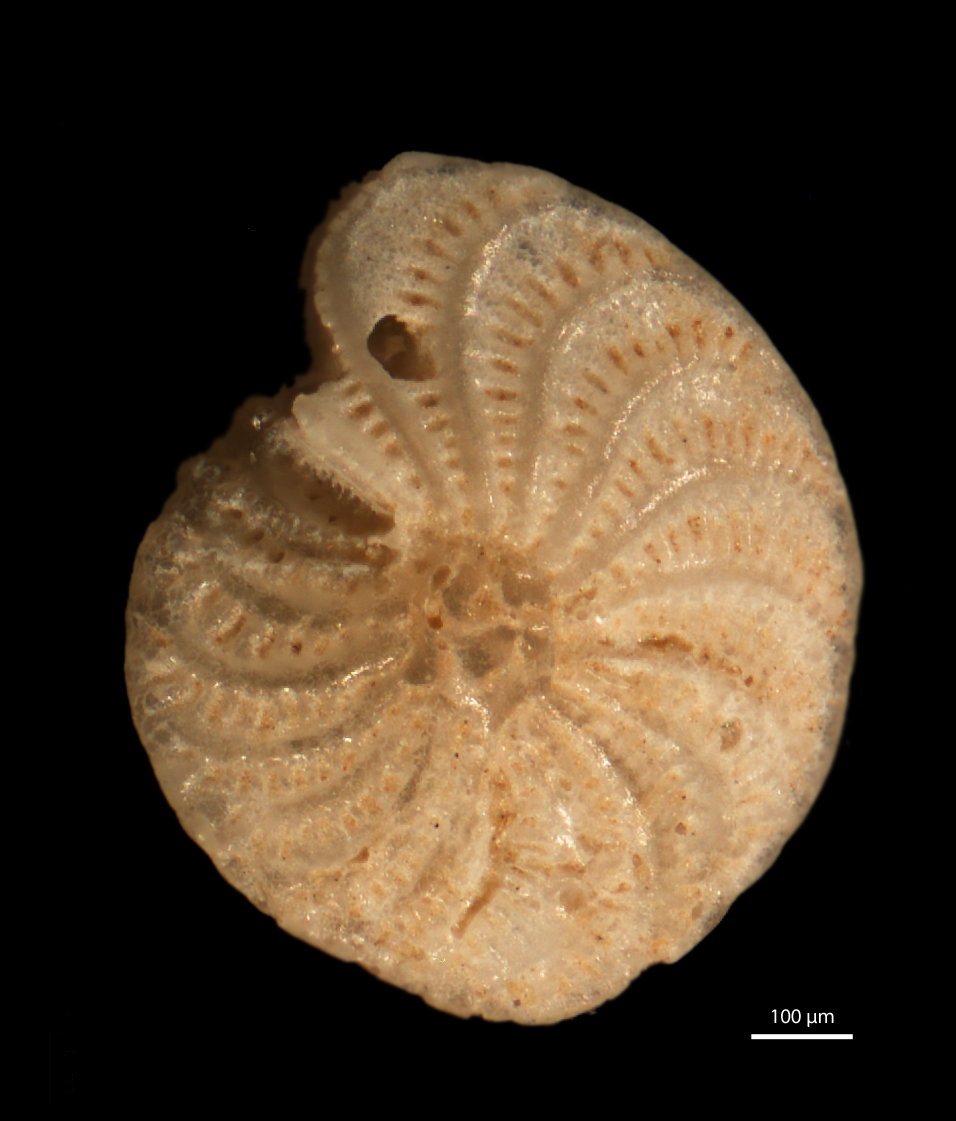Genus – Elphidium
Genus Elphidium de Montfort, 1808
Loeblich and Tappan (1964, pp. C631-635) redecribed the genus with illustrations and provided details of synonymies and the numerous generic revisions on de Montfort’s short original description.
Description from Loeblich and Tappan, 1964: Test planispiral, bilaterally symmetrical, involute, chambers numerous, with numerous retral processes or internal chamber projections along septal borders, ending blindly against septal face in final chamber, but pierced by tiny pore formed by resorption of septum at base of retral process in earlier chambers; septa secondarily doubled, incomplete septal flap being formed against apertural face as succeeding chamber forms, leaving septum single-layered near center and base and double near outer edge where it encloses canal system, with prominent lamellar thickening of outer wall; canal system complex, spiral canal present along umbilical chamber margin leading to vertical umbilical canals through umbilical plug, and also giving rise to subsutural septal canals at each septum in intraseptal space between septal face and septal flap, formed by succeeding chamber and lying below retal processes, communicating with the surface by means of diverging canals; walls calcareous, finely perforate, radial in structure, surface commonly coinciding with grooves (fossettes) or ridges paralleling periphery (striped crenulations) and commonly coinciding with internal retral process, or surface may be smooth or finely pustulous; aperture consisting of a row of pores at base of septal face.
Elphidium frigidum Cushman, 1933
Elphidium frigidum Cushman 1933, p. 5, pl. 1, figs. 8a, b; Cushman and McCulloch, 1939, p. 171, pl. 19, figs. 6, 8; Cushman and Todd, 1947, p. 14, pl. 2, fig. 18.; Cushman, 1948, p. 57, pl. 6, figs. 9–11.
Cribroelphidium frigidum (Cushman), Lankford and Phleger, 1971, p. 118, pl. 3, figs. 20a, b.
Description: Test usually completely involute, compressed, periphery rounded, lobulated, umbilical region depressed; chambers distinct, inflated, especially in the latter portion, the final chamber often enlarged and projecting beyond the general contour of the tests; sutures distinct, depressed, with very numerous short retral processes; wall thin, very distinctly perforate, the later-forming chambers often having distinct elongate markings; aperture consisting of numerous fine pores at the base of the apertural face of the last-forming chamber. Length 0.61-1.00 mm
Remarks: Cushman (1933) noted that E. frigidum “shows considerable variation in the shape of the last-formed chamber, which is much expanded in the adult and often longer than the others so that it projects beyond the general outline of the test. The apertural face of the chamber has peculiar overlapping border at the base extending out somewhat beyond the base of the chamber both along the median line and also towards the umbilical ends.”
Distribution: Cushman and McCulloch (1939) note that E. frigidum is typically an Arctic species and is found in shallow water in Alaska and deeper, cool water off California. It is not common in Puget Sound.
Elphidium crispum (Linnaeus, 1758)
Nautilus crispus LInneas, 1758, p. 709.
Polystoma crispa Lamarck, 1822, p. 625; d’Orbigny, 1826, p. 238; Parker Jones and Brady, 1865, p. 26, pl. 3, fig. 96.
Elphidium crispum Cushman and Grant, 1927, p. 73, pl. 7, figs. 3a, b; Cushman and Valentine, 1930, p. 21, pl. 5, figs. 12a, b; Cushman, 1939, p. 50, pl. 3, figs. 17-21; Cushman and McCullogh, 1940, p. 174-6, pl. 20, fig. 5; McGann, 2007, p. 66, pl. 10, fig EE.
Description from Cushman and McCulloch (1940): Test large size for genus, about 2 ½ times longer than wide in peripheral view, lenticular, completely involute; the umbilical region with a medium-sized, slightly projecting, rounded boss of clear shell material, the surface if which is set with 10 to 12 small, shallow, rounded pits, periphery sharply angular but not sharply keeled, sometimes becoming lightly lobate and blunt in the last portion of the adult coil; chambers very numerous, 20 to 40, long and narrow, the last few often inflated, forward part slightly raised giving a radially ribbed appearance; sutures somewhat sigmoid, the middle portion of each nearly radial, often partially obscured by the retral processes, set with pores; wall finely perforate with about 12 relatively long retral processes extending well up onto the side of the next added chamber; aperture a row of small openings at the base of the apertural face which is low sagittate, the sides often slightly concave, the ends pointed. Diameter up to 3 mm, thickness 0.4-1.0 mm.
Distribution: E. crispum is widely distributed globally. It is not common in Puget Sound but is found around the San Juan Islands and rarely in the central Sound.


